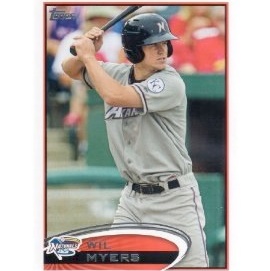 Let’s begin with this: On Sunday, December 9, the Kansas City Royals acquired pitchers James Shields and Wade Davis (as well as a player yet to be named) from the Tampa Bay Rays in exchange for Wil Myers, Jake Odorizzi, Mike Montgomery, and Patrick Leonard. It will be five months before we begin to see the deal’s consequences. It will likely be at least a handful of seasons before we are able to evaluate a true winner.
Let’s begin with this: On Sunday, December 9, the Kansas City Royals acquired pitchers James Shields and Wade Davis (as well as a player yet to be named) from the Tampa Bay Rays in exchange for Wil Myers, Jake Odorizzi, Mike Montgomery, and Patrick Leonard. It will be five months before we begin to see the deal’s consequences. It will likely be at least a handful of seasons before we are able to evaluate a true winner.
(Do you remember the 2007 Braves’ acquisition of Mark Teixeira from the Rangers for Elvis Andrus, Neftali Feliz, Matt Harrison, and Jarrod Saltalamacchia? Andrus debuted in the Major Leagues in 2009, Feliz broke through in 2010, and Harrison established himself in 2011, four years after the trade was finalized. Meanwhile, mega-prospect Saltalamacchia never did pan out for the Rangers, though his 2012 season for the Boston Red Sox wasn’t bad.)
Ah, but why wait till April 2013 (or 2017) to have a good debate? Thus have numerous pundits written, intelligently, that the Rays swiped the Royals’ top prospect in Myers along with a trio of promising mates in exchange for Tampa’s third best starter, if that, and a swingman. This has caused contrarian pundits to pen, equally astutely, that Kansas City plucked a pair of Major League arms from Tampa Bay in exchange for potential but nothing substantive.
These are all very appealing things to consider.
Instead, I’d rather think about Wil Myers’ rookie card — and its insignificance.
There was a time, not too long ago, when the two words “rookie card” meant something glorious and attractive — without the need to add in a “PSA/DNA” qualifier. As a player’s very first professional card, his rookie card might capture him in his first year in the Major Leagues, mark him as an Olympian for Team USA, or discover him as a draft pick just out of high school. Pulling a player’s rookie card out of a freshly opened pack was cause for celebration, especially if the player in question was just about to burst onto the scene. Donruss added a “Rated Rookie” insignia; Topps rainbowed the words “Future Star” over the player’s name or included its golden All-Star Trophy honor on the card of a second-year player who had distinguished himself in his debut season.
As the prices for 1950s-1970s baseball cards skyrocketed during the late 1980s and into the ’90s, rookie cards grabbed both the attention and the imagination of the young fan and the enterprising adult. It wasn’t enough to collect the rookie cards of baseball past and current stars; now the hunt was on for the next generation of phenoms. The 1986 Topps Traded set, with its Wally Joyner, Barry Bonds, Jose Canseco, Bobby Bonilla, Will Clark, Bo Jackson, and Danny Tartabull rookies (among numerous others) became hugely coveted. The Mets’ Gregg Jefferies sizzled into potential prominence in 1988; Ken Griffey, Jr.’s rookie card single-handedly made Upper Deck’s debut in 1989 a success; and Frank Thomas’s 1990 Topps draft pick was heavily sought after, particularly once the rumor of a legendary “no name on front” Thomas card surfaced. Its listed price in Beckett? Hundreds of dollars, enough to mark it as a holy grail for any collector.
Encouraged by the success, card companies began delving further into each team’ minor league system to print the rookie cards of the top youngsters before their competitors. (They also began overproducing the quantities of cards at alarming rates. At the same time that numerous middle-aged men were bemoaning the loss of their childhood collection, Topps, Fleer, and Donruss were assuring that the world would never be at a loss for their late-’80s/early-’90s designs.)
With unfamiliar players now arriving in sets by the dozens, particularly Bowman, collectors and dealers began to educate themselves on each team’s top prospects. The baseball card analysts in my favorite magazine now doubled as minor league analysts, assuring me of the future greatness in store for David Borkowski, Dermal (“Dee”) Brown, Matt Riley, and the unforgettable Ntema (“Papy”) Ndungidi.
Unfortunately, in a tradition dating back farther than David Clyde and Clint Hartung, some prospects bust. Hey, so maybe Todd Van Poppel’s career didn’t work out, Eric Munson never became a star, and Ryan Minor ended up as a Cal Ripken trivia footnote. It happens. Their rookie cards shot up in value during their promising years and came right back down to Earth when their fates were sealed.
The problem comes with the other players, the ones who actually carved out a pretty solid career for themselves: Tony Clark. Richard Hidalgo. Pat Burrell. At one point, their rookie cards were in the stratosphere. Then they reached the Majors, it became apparent that Cooperstown was not in the cards, and their rookie cards sank. From my best recollection, actually, pretty much everyone’s rookie card value sinks once they make the Major Leagues, especially once they’ve been there for a little bit. Being a solid to above-average player, apparently, is not good enough for the collectors and dealers. If you’re not Bryce Harper or Mike Trout, you’re clearly not as good as the collectors and dealers thought you were.
This is where Wil Myers (and, to a lesser extent, his fellow prospects) enters the picture. It is December. People are arguing. Myers’ rookie card is hot.
In the grand scheme of baseball card collecting, these might very well be the best days for that rookie card. If he starts 2013 successfully, the best days might very well be during the opening months of the season. It’s all downhill after that.
But in the grand scheme of Wil Myers’ baseball career, his best days lie ahead of him for years and years to come, and there’s no amount of punditry or cardboard business that’s going to have any say in the matter.
—-
Share your news with the baseball community. Send it to us at editors@augustpublications.com.
Are you a subscriber to the weekly Ballpark Digest newsletter? You can sign up for a free subscription at the Newsletter Signup Page.
Join Ballpark Digest on Facebook and on Twitter!
Follow Ballpark Digest on Google + and add us to your circles!
